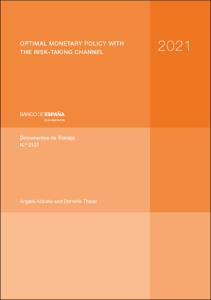Optimal monetary policy with the risk-taking channel
Autor
Fecha de publicación
28-oct-2021
Descripción física
53 p.
Resumen
La investigación empírica sugiere que los tipos de interés más bajos inducen a los bancos a asumir mayores riesgos. Analizamos lo que este canal de toma de riesgos implica para la política monetaria óptima en un modelo neokeynesiano manejable. Mostramos que este canal crea un motivo para que el planificador estabilice el tipo real. Este objetivo entra en conflicto con el objetivo estándar de estabilización de la inflación. Por tanto, la política óptima tolera una mayor volatilidad de la inflación. Una función de reacción inercial de tipo Taylor deviene óptima. También cuantificamos la importancia del canal de toma de riesgos para la política monetaria en una extensión estimada de mediana escala del modelo. Ignorar el canal a la hora de diseñar la política monetaria conlleva unos costes de bienestar no despreciables (equivalentes al 0,7 % del consumo de por vida).
Empirical research suggests that lower interest rates induce banks to take higher risks. We assess analytically what this risk-taking channel implies for optimal monetary policy in a tractable New Keynesian model. We show that this channel creates a motive for the planner to stabilize the real rate. This objective conflicts with the standard inflation stabilization objective. Optimal policy thus tolerates more inflation volatility. An inertial Taylor-type reaction function becomes optimal. We then quantify the significance of the risk-taking channel for monetary policy in an estimated medium-scale extension of the model. Ignoring the channel when designing policy entails non-negligible welfare costs (0.7% lifetime consumption equivalent).
Empirical research suggests that lower interest rates induce banks to take higher risks. We assess analytically what this risk-taking channel implies for optimal monetary policy in a tractable New Keynesian model. We show that this channel creates a motive for the planner to stabilize the real rate. This objective conflicts with the standard inflation stabilization objective. Optimal policy thus tolerates more inflation volatility. An inertial Taylor-type reaction function becomes optimal. We then quantify the significance of the risk-taking channel for monetary policy in an estimated medium-scale extension of the model. Ignoring the channel when designing policy entails non-negligible welfare costs (0.7% lifetime consumption equivalent).
Publicado en
Documentos de Trabajo / Banco de España, 2137
Materias
Canal de toma de riesgos; Política monetaria óptima; Tipo de política; Risk-taking channel; Optimal monetary policy; Inertial policy rate; Teoría monetaría; Política monetaria
Aparece en las colecciones:












